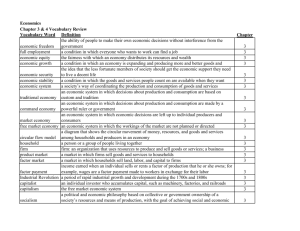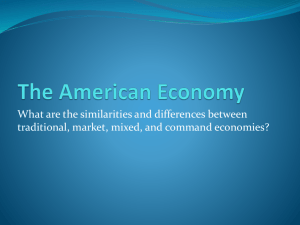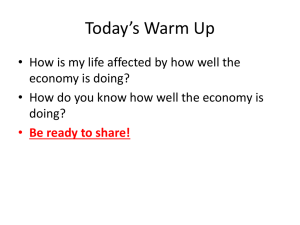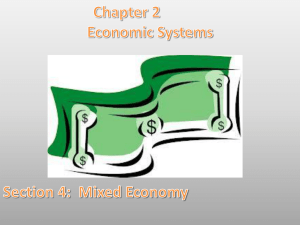economic system
advertisement
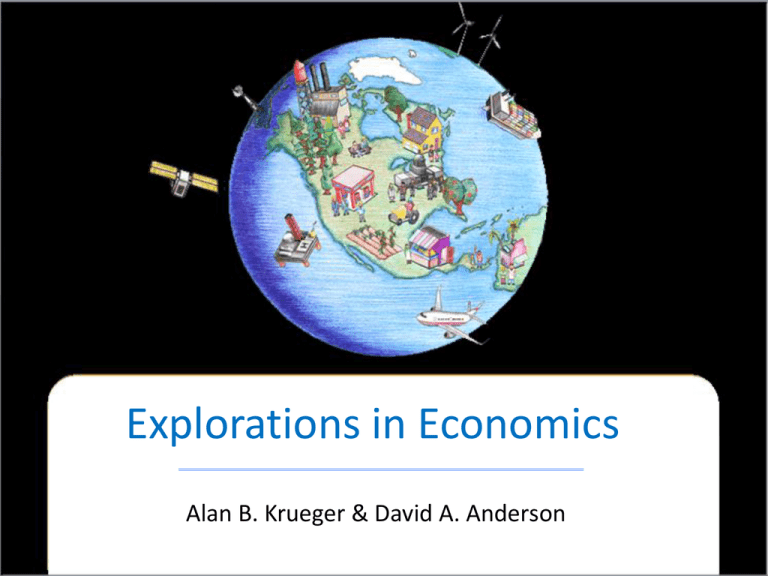
Explorations in Economics Alan B. Krueger & David A. Anderson Chapter 2: Comparing Economic Systems - Module 4: Using Resources to Achieve Economic Goals - Module 5: Types of Economic Systems - Module 6: The Modern Market Economy MODULE 4: Using Resources to Achieve Economic Goals KEY IDEA: Every society must determine how to use its resources to achieve its economic goals. OBJECTIVES: • To explain the three basic economic questions. • To identify five economic goals that societies pursue. • To describe tradeoffs made among the five goals. THE THREE BASIC ECONOMIC QUESTIONS 1. What should be produced? 2. How should it be produced? 3. For whom should it be produced? Are your favorite goods produced? • Is your favorite food sold? • Is your least favorite food sold? • If your favorite food is easier to find then your least favorite world, resources are being allocated well to serve your dietary needs. 4/13/2015 Chapter 2: Modules 4,5 & 6 How should we produce a guitar? • A guitar can be made by workers • A guitar can be made alone • Small number of jigsaws • Industrial robots • Materials- lots of decisions need to be placed 4/13/2015 Chapter 2: Modules 4,5 & 6 For whom should it be produced? • One must think about their target audience • Demographics • SES • Age • Potential changes in that field 4/13/2015 Chapter 2: Modules 4,5 & 6 SOCIETY’S ECONOMIC GOALS The standard of living is a measure of comfort in terms of the goods and services available. Economic Goals: • Economic Growth- correlated to standard of living • Efficiency- example of meat in India • Equity- sense of fairness • Economic Security- the confidence and ability to support themselves and their families; leads to a social safety netgives assistance to those in needs • Economic Freedom- people the ability to make economic decisions for themselves • Quality of life • Sustainability TRADEOFFS AMONG GOALS Tradeoffs force societies to prioritize among economic goals. When the gains from change exceed the losses, it is possible to achieve an improved standard of living without neglecting the goals of equity and economic security. MODULE 4 REVIEW What is… A. Standard of living? B. Equity? C. Efficiency? D. Economic security? E. Social safety net? F. Economic freedom? G. Allocated? H. Equality of outcome? I. Equality of opportunity? J. Economic growth? MODULE 5: Types of Economic Systems KEY IDEA: A country’s economic system determines how well it can achieve each economic goal. OBJECTIVES: •To explain what an economic system is and how incentives play a role. •To describe the features of a traditional economy, a command economy, a market economy, and a mixed economy. ECONOMIC SYSTEMS AND INCENTIVES An economic system is an organizational structure for addressing what, how, and for whom to produce. An incentive is the prospect of a reward or punishment that influences a decision or motivates greater effort. TRADITIONAL ECONOMIES In a traditional economy, decisions about resources are made by habit, custom, superstition, or religious tradition. COMMAND ECONOMIES In a command economy, central planners make the important decisions about what, how, and for whom to produce. Communism is a political- economic system under which all resources and businesses are publicly owned and economic decisions are made by central authorities. Socialism is an economic system under which most resources and businesses are publicly owned and economic decisions are made by groups of workers and consumers. MARKET ECONOMIES In a market economy, most key economic decisions are made by business owners and consumers. In a capitalist system, most resources and businesses are privately owned. A free- enterprise system is an economic system based on private(individual or business) ownership of resources and voluntary exchange. MIXED ECONOMIES A mixed economy combines a market economy with significant government involvement and elements of tradition. Governments in market economies have expanded their roles in the pursuit of equity, economic security, and sustainability. ECONOMIC SYSTEMS MODULE 5 REVIEW What is… A. Economic system? B. Traditional economy? C. Incentive? D. Command economy? E. Communism? F. Socialism? G. Rationing? H. Market economy? I. Capitalist system? J. Free- enterprise system? K. Mixed economy? MODULE 6: The Modern Market Economy KEY IDEA: In modern market economies, government participation can support market exchanges and improve economic performance. OBJECTIVES: •To explain the relationship among households, firms, and markets in a market economy. •To explain the government’s role in a market economy. •To describe how the government fits into the circular flow model of the economy. •To describe the tradeoffs different countries make in designing social safety nets. HOUSEHOLDS, FIRMS, AND MARKETS A household consists of an individual or a group of people who live together and share income, such as you and your family. 1. Households purchase goods and services from businesses. 2. Households provide land, labor, capital, and entrepreneurship (resources) from which goods and services are produced. HOUSEHOLDS, FIRMS, AND MARKETS A firm is a privately owned organization that produces goods or services and sells them to others. THE SIMPLE CIRCULAR FLOW THE SIMPLE CIRCULAR FLOW Product markets are where goods and services are exchanged for money. Factor markets are where resources are exchanged for money. GOVERNMENT’S ROLE IN A MARKET ECONOMY 1. A government can establish and enforce rules that improve market performance. 2. A government can provide important goods and services that private individuals tend not to purchase. 3. A government can help improve economic security, equity, and sustainability. GOVERNMENT IN THE CIRCULAR FLOW A public good is a good or service that can be consumed by many people at once and that other people can’t be prevented from using. Transfer payments are expenditures for which the government receives no good, service, or resource in return. Government in the Circular Flow INTERNATIONAL PERSPECTIVES Countries have to decide if they want a strong safety net or a weak one. More public goods and transfer payments tend to increase the tax rate. Module 6 Review What is… A. Household? B. Firm? C. Circular flow diagram? D. Product market? E. Factor market? F. Factor payment? G. Property right? H. Public good? I. Transfer payment? J. Regulation?
